Global Environment Report: Management and Organisation, Course Name
VerifiedAdded on 2020/03/01
|8
|1534
|54
Report
AI Summary
This report, focusing on management and organisation in a global environment, begins by applying Taylor's principles to modern business, including call centers, to enhance productivity and competitiveness. It then delves into Friedman's views on globalisation, examining its risks and the concept of a 'flat world.' The report also discusses the importance of seizing opportunities and the uneven distribution of globalisation's benefits. Activity-1 explores Taylor’s principles in the modern world, and Activity-2 deals with Friedman’s rule about globalisation. The report concludes with a summary of the main points and their implications for businesses operating in a global context. It emphasizes the importance of productivity, competitive advantage, and understanding the dynamics of globalization to succeed in today's world. The report utilizes various sources, including academic journals and online resources, to support its arguments.
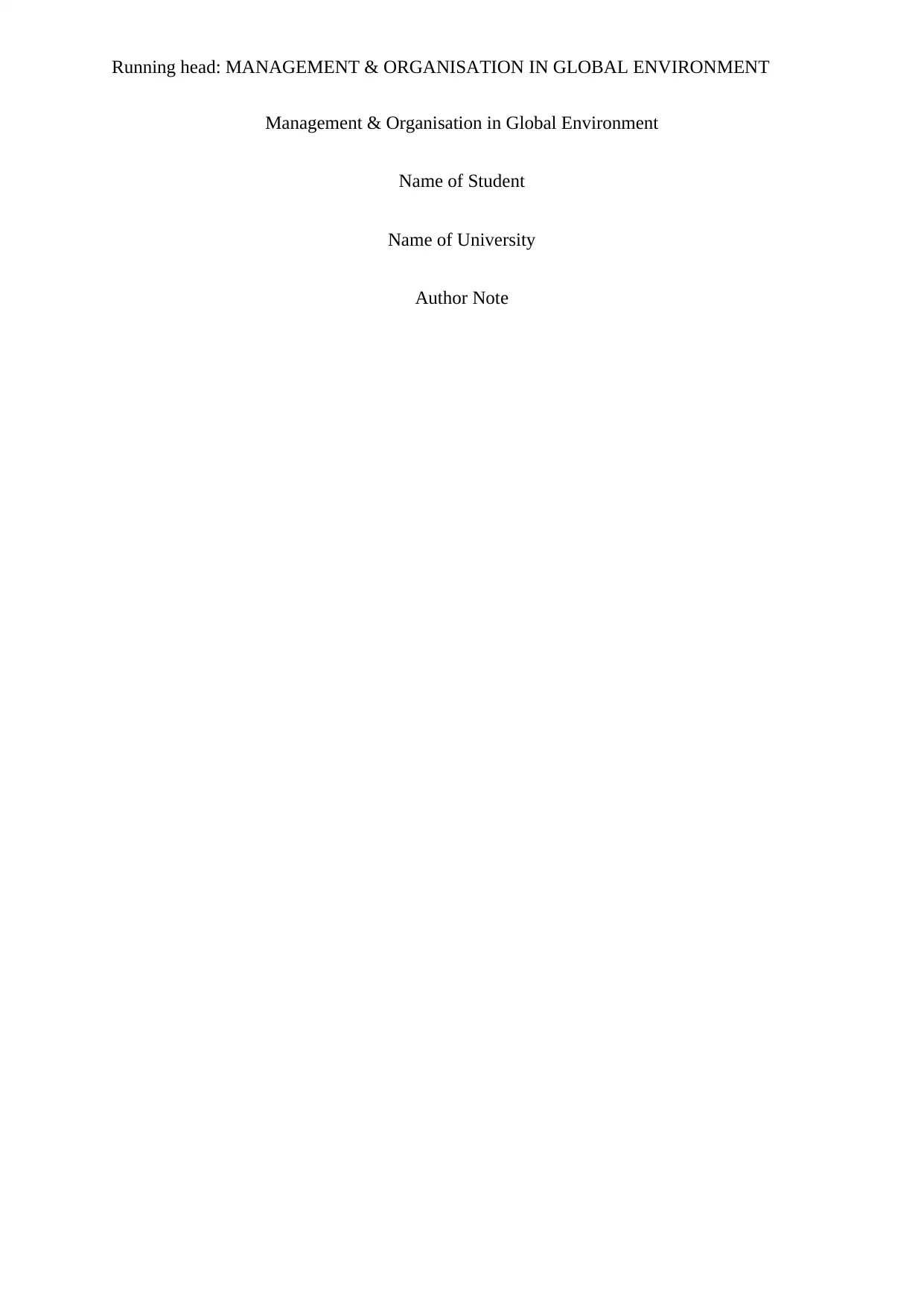
Running head: MANAGEMENT & ORGANISATION IN GLOBAL ENVIRONMENT
Management & Organisation in Global Environment
Name of Student
Name of University
Author Note
Management & Organisation in Global Environment
Name of Student
Name of University
Author Note
Paraphrase This Document
Need a fresh take? Get an instant paraphrase of this document with our AI Paraphraser
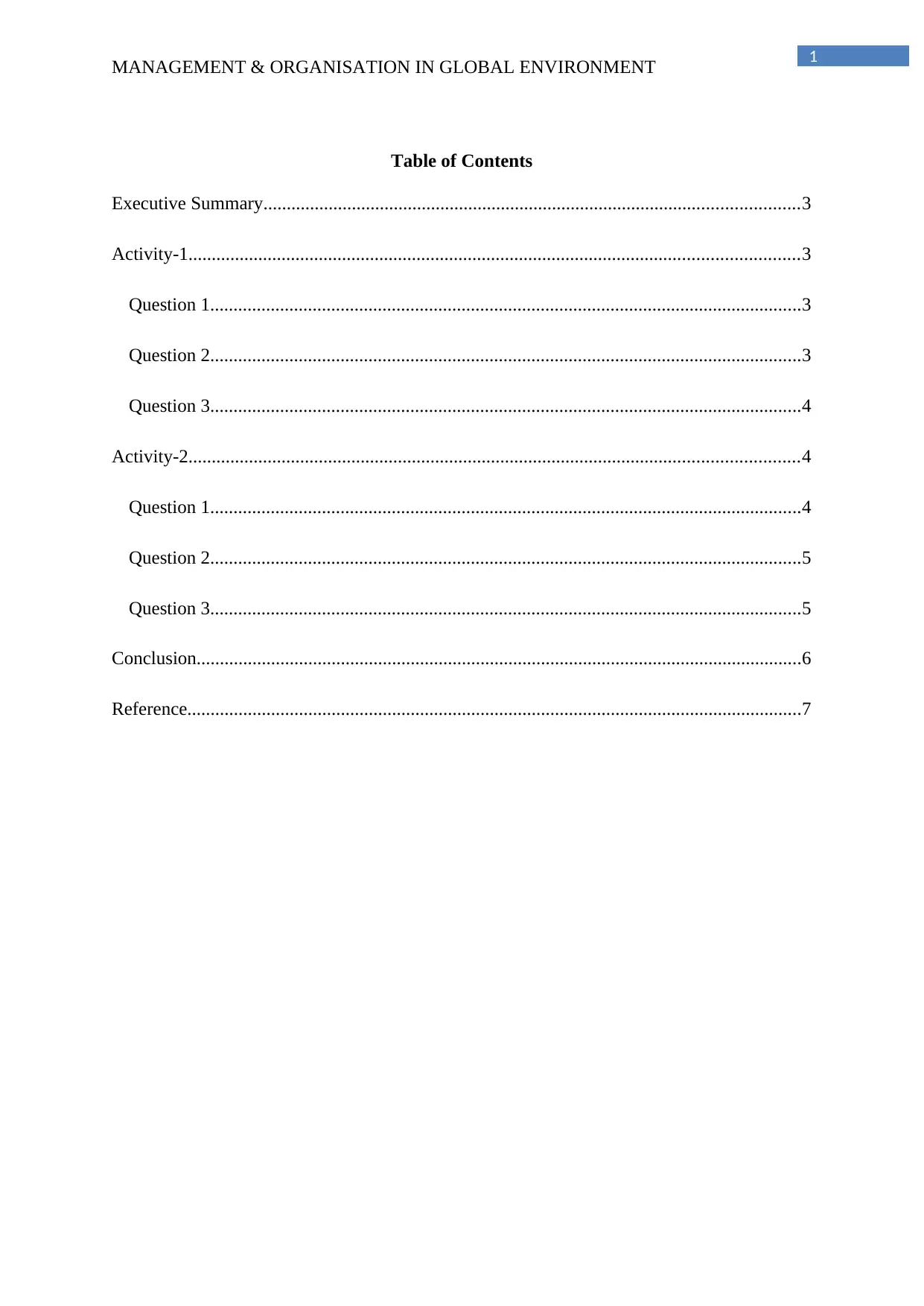
1
MANAGEMENT & ORGANISATION IN GLOBAL ENVIRONMENT
Table of Contents
Executive Summary...................................................................................................................3
Activity-1...................................................................................................................................3
Question 1...............................................................................................................................3
Question 2...............................................................................................................................3
Question 3...............................................................................................................................4
Activity-2...................................................................................................................................4
Question 1...............................................................................................................................4
Question 2...............................................................................................................................5
Question 3...............................................................................................................................5
Conclusion..................................................................................................................................6
Reference....................................................................................................................................7
MANAGEMENT & ORGANISATION IN GLOBAL ENVIRONMENT
Table of Contents
Executive Summary...................................................................................................................3
Activity-1...................................................................................................................................3
Question 1...............................................................................................................................3
Question 2...............................................................................................................................3
Question 3...............................................................................................................................4
Activity-2...................................................................................................................................4
Question 1...............................................................................................................................4
Question 2...............................................................................................................................5
Question 3...............................................................................................................................5
Conclusion..................................................................................................................................6
Reference....................................................................................................................................7
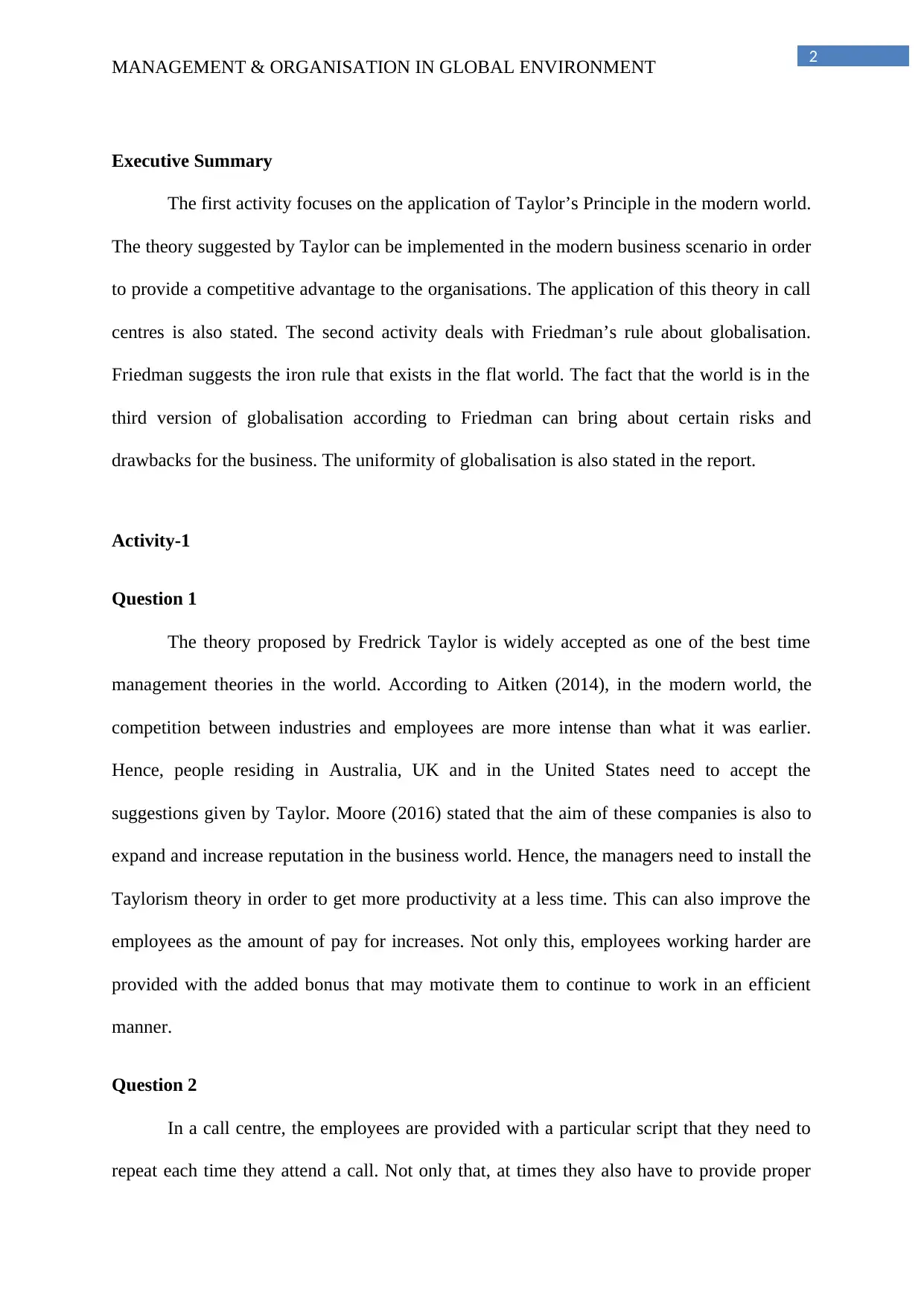
2
MANAGEMENT & ORGANISATION IN GLOBAL ENVIRONMENT
Executive Summary
The first activity focuses on the application of Taylor’s Principle in the modern world.
The theory suggested by Taylor can be implemented in the modern business scenario in order
to provide a competitive advantage to the organisations. The application of this theory in call
centres is also stated. The second activity deals with Friedman’s rule about globalisation.
Friedman suggests the iron rule that exists in the flat world. The fact that the world is in the
third version of globalisation according to Friedman can bring about certain risks and
drawbacks for the business. The uniformity of globalisation is also stated in the report.
Activity-1
Question 1
The theory proposed by Fredrick Taylor is widely accepted as one of the best time
management theories in the world. According to Aitken (2014), in the modern world, the
competition between industries and employees are more intense than what it was earlier.
Hence, people residing in Australia, UK and in the United States need to accept the
suggestions given by Taylor. Moore (2016) stated that the aim of these companies is also to
expand and increase reputation in the business world. Hence, the managers need to install the
Taylorism theory in order to get more productivity at a less time. This can also improve the
employees as the amount of pay for increases. Not only this, employees working harder are
provided with the added bonus that may motivate them to continue to work in an efficient
manner.
Question 2
In a call centre, the employees are provided with a particular script that they need to
repeat each time they attend a call. Not only that, at times they also have to provide proper
MANAGEMENT & ORGANISATION IN GLOBAL ENVIRONMENT
Executive Summary
The first activity focuses on the application of Taylor’s Principle in the modern world.
The theory suggested by Taylor can be implemented in the modern business scenario in order
to provide a competitive advantage to the organisations. The application of this theory in call
centres is also stated. The second activity deals with Friedman’s rule about globalisation.
Friedman suggests the iron rule that exists in the flat world. The fact that the world is in the
third version of globalisation according to Friedman can bring about certain risks and
drawbacks for the business. The uniformity of globalisation is also stated in the report.
Activity-1
Question 1
The theory proposed by Fredrick Taylor is widely accepted as one of the best time
management theories in the world. According to Aitken (2014), in the modern world, the
competition between industries and employees are more intense than what it was earlier.
Hence, people residing in Australia, UK and in the United States need to accept the
suggestions given by Taylor. Moore (2016) stated that the aim of these companies is also to
expand and increase reputation in the business world. Hence, the managers need to install the
Taylorism theory in order to get more productivity at a less time. This can also improve the
employees as the amount of pay for increases. Not only this, employees working harder are
provided with the added bonus that may motivate them to continue to work in an efficient
manner.
Question 2
In a call centre, the employees are provided with a particular script that they need to
repeat each time they attend a call. Not only that, at times they also have to provide proper
⊘ This is a preview!⊘
Do you want full access?
Subscribe today to unlock all pages.

Trusted by 1+ million students worldwide
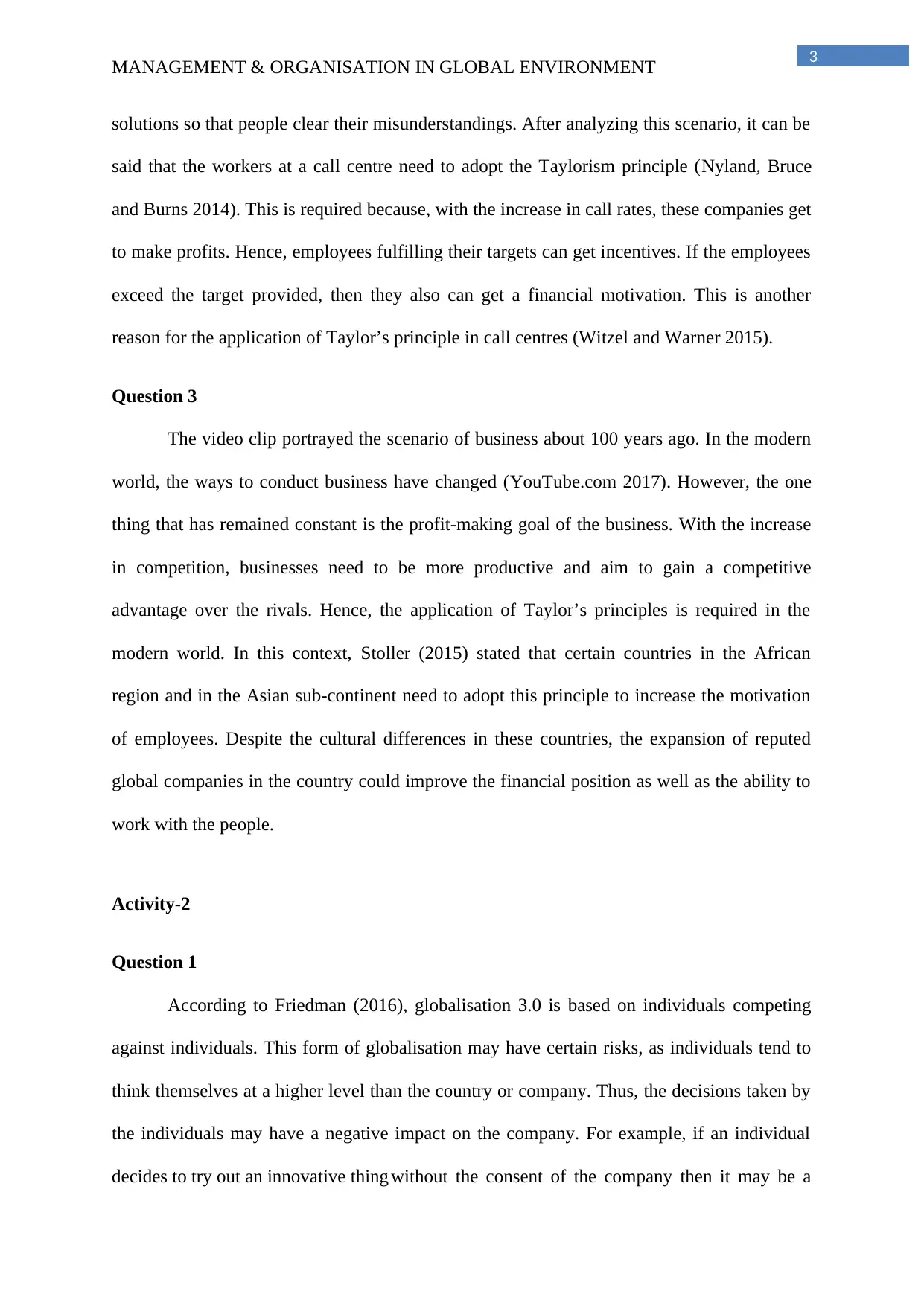
3
MANAGEMENT & ORGANISATION IN GLOBAL ENVIRONMENT
solutions so that people clear their misunderstandings. After analyzing this scenario, it can be
said that the workers at a call centre need to adopt the Taylorism principle (Nyland, Bruce
and Burns 2014). This is required because, with the increase in call rates, these companies get
to make profits. Hence, employees fulfilling their targets can get incentives. If the employees
exceed the target provided, then they also can get a financial motivation. This is another
reason for the application of Taylor’s principle in call centres (Witzel and Warner 2015).
Question 3
The video clip portrayed the scenario of business about 100 years ago. In the modern
world, the ways to conduct business have changed (YouTube.com 2017). However, the one
thing that has remained constant is the profit-making goal of the business. With the increase
in competition, businesses need to be more productive and aim to gain a competitive
advantage over the rivals. Hence, the application of Taylor’s principles is required in the
modern world. In this context, Stoller (2015) stated that certain countries in the African
region and in the Asian sub-continent need to adopt this principle to increase the motivation
of employees. Despite the cultural differences in these countries, the expansion of reputed
global companies in the country could improve the financial position as well as the ability to
work with the people.
Activity-2
Question 1
According to Friedman (2016), globalisation 3.0 is based on individuals competing
against individuals. This form of globalisation may have certain risks, as individuals tend to
think themselves at a higher level than the country or company. Thus, the decisions taken by
the individuals may have a negative impact on the company. For example, if an individual
decides to try out an innovative thing without the consent of the company then it may be a
MANAGEMENT & ORGANISATION IN GLOBAL ENVIRONMENT
solutions so that people clear their misunderstandings. After analyzing this scenario, it can be
said that the workers at a call centre need to adopt the Taylorism principle (Nyland, Bruce
and Burns 2014). This is required because, with the increase in call rates, these companies get
to make profits. Hence, employees fulfilling their targets can get incentives. If the employees
exceed the target provided, then they also can get a financial motivation. This is another
reason for the application of Taylor’s principle in call centres (Witzel and Warner 2015).
Question 3
The video clip portrayed the scenario of business about 100 years ago. In the modern
world, the ways to conduct business have changed (YouTube.com 2017). However, the one
thing that has remained constant is the profit-making goal of the business. With the increase
in competition, businesses need to be more productive and aim to gain a competitive
advantage over the rivals. Hence, the application of Taylor’s principles is required in the
modern world. In this context, Stoller (2015) stated that certain countries in the African
region and in the Asian sub-continent need to adopt this principle to increase the motivation
of employees. Despite the cultural differences in these countries, the expansion of reputed
global companies in the country could improve the financial position as well as the ability to
work with the people.
Activity-2
Question 1
According to Friedman (2016), globalisation 3.0 is based on individuals competing
against individuals. This form of globalisation may have certain risks, as individuals tend to
think themselves at a higher level than the country or company. Thus, the decisions taken by
the individuals may have a negative impact on the company. For example, if an individual
decides to try out an innovative thing without the consent of the company then it may be a
Paraphrase This Document
Need a fresh take? Get an instant paraphrase of this document with our AI Paraphraser
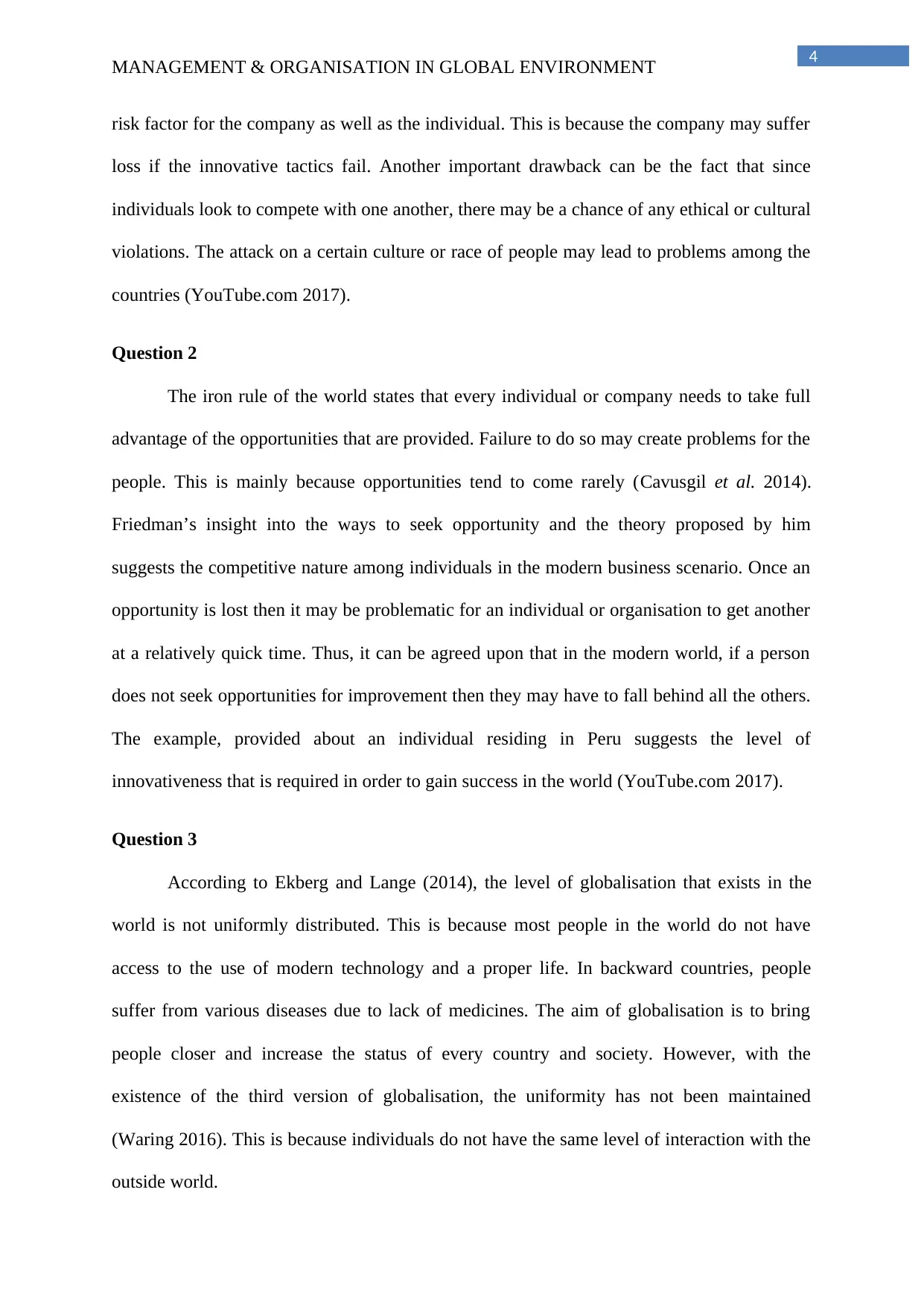
4
MANAGEMENT & ORGANISATION IN GLOBAL ENVIRONMENT
risk factor for the company as well as the individual. This is because the company may suffer
loss if the innovative tactics fail. Another important drawback can be the fact that since
individuals look to compete with one another, there may be a chance of any ethical or cultural
violations. The attack on a certain culture or race of people may lead to problems among the
countries (YouTube.com 2017).
Question 2
The iron rule of the world states that every individual or company needs to take full
advantage of the opportunities that are provided. Failure to do so may create problems for the
people. This is mainly because opportunities tend to come rarely (Cavusgil et al. 2014).
Friedman’s insight into the ways to seek opportunity and the theory proposed by him
suggests the competitive nature among individuals in the modern business scenario. Once an
opportunity is lost then it may be problematic for an individual or organisation to get another
at a relatively quick time. Thus, it can be agreed upon that in the modern world, if a person
does not seek opportunities for improvement then they may have to fall behind all the others.
The example, provided about an individual residing in Peru suggests the level of
innovativeness that is required in order to gain success in the world (YouTube.com 2017).
Question 3
According to Ekberg and Lange (2014), the level of globalisation that exists in the
world is not uniformly distributed. This is because most people in the world do not have
access to the use of modern technology and a proper life. In backward countries, people
suffer from various diseases due to lack of medicines. The aim of globalisation is to bring
people closer and increase the status of every country and society. However, with the
existence of the third version of globalisation, the uniformity has not been maintained
(Waring 2016). This is because individuals do not have the same level of interaction with the
outside world.
MANAGEMENT & ORGANISATION IN GLOBAL ENVIRONMENT
risk factor for the company as well as the individual. This is because the company may suffer
loss if the innovative tactics fail. Another important drawback can be the fact that since
individuals look to compete with one another, there may be a chance of any ethical or cultural
violations. The attack on a certain culture or race of people may lead to problems among the
countries (YouTube.com 2017).
Question 2
The iron rule of the world states that every individual or company needs to take full
advantage of the opportunities that are provided. Failure to do so may create problems for the
people. This is mainly because opportunities tend to come rarely (Cavusgil et al. 2014).
Friedman’s insight into the ways to seek opportunity and the theory proposed by him
suggests the competitive nature among individuals in the modern business scenario. Once an
opportunity is lost then it may be problematic for an individual or organisation to get another
at a relatively quick time. Thus, it can be agreed upon that in the modern world, if a person
does not seek opportunities for improvement then they may have to fall behind all the others.
The example, provided about an individual residing in Peru suggests the level of
innovativeness that is required in order to gain success in the world (YouTube.com 2017).
Question 3
According to Ekberg and Lange (2014), the level of globalisation that exists in the
world is not uniformly distributed. This is because most people in the world do not have
access to the use of modern technology and a proper life. In backward countries, people
suffer from various diseases due to lack of medicines. The aim of globalisation is to bring
people closer and increase the status of every country and society. However, with the
existence of the third version of globalisation, the uniformity has not been maintained
(Waring 2016). This is because individuals do not have the same level of interaction with the
outside world.
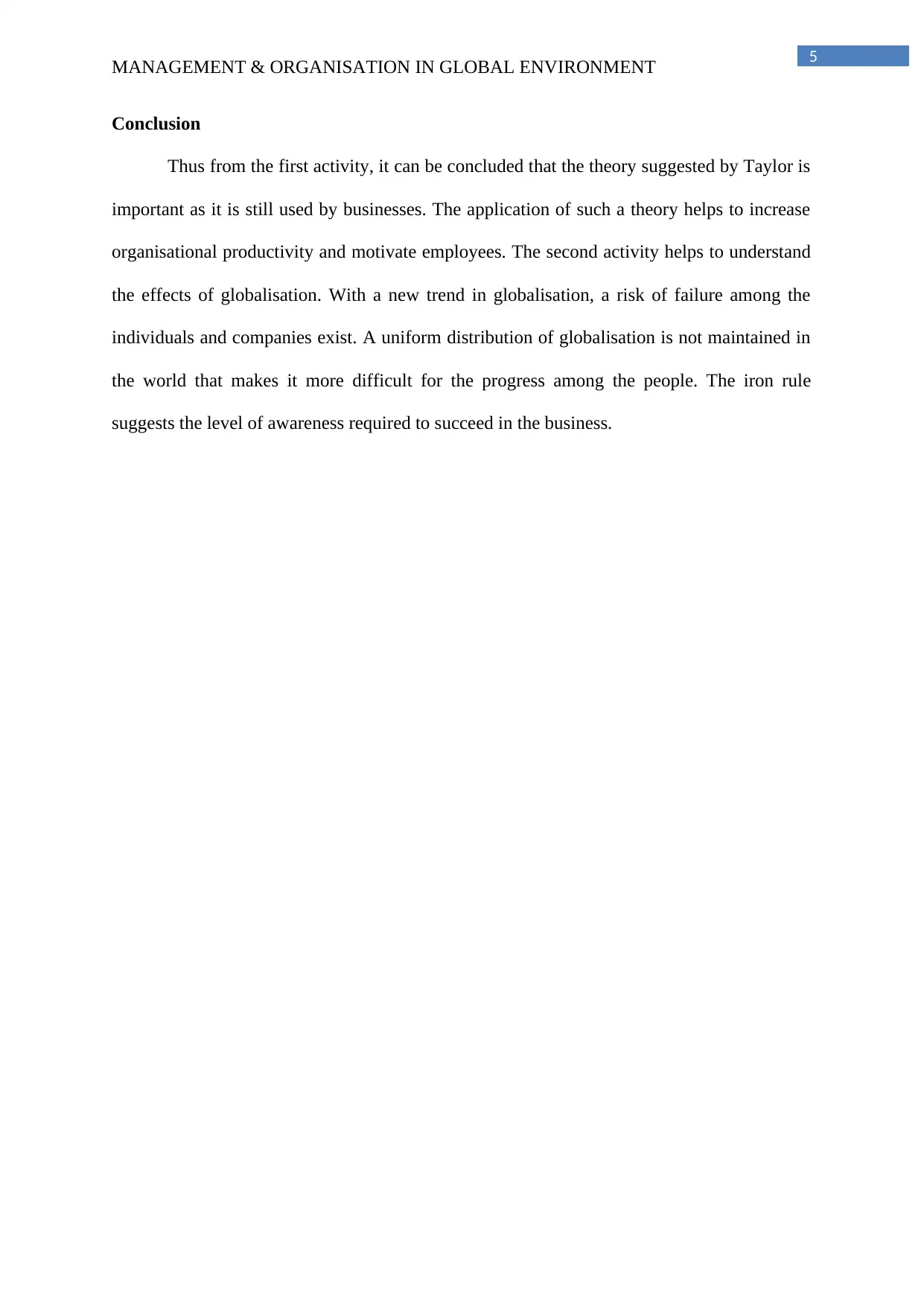
5
MANAGEMENT & ORGANISATION IN GLOBAL ENVIRONMENT
Conclusion
Thus from the first activity, it can be concluded that the theory suggested by Taylor is
important as it is still used by businesses. The application of such a theory helps to increase
organisational productivity and motivate employees. The second activity helps to understand
the effects of globalisation. With a new trend in globalisation, a risk of failure among the
individuals and companies exist. A uniform distribution of globalisation is not maintained in
the world that makes it more difficult for the progress among the people. The iron rule
suggests the level of awareness required to succeed in the business.
MANAGEMENT & ORGANISATION IN GLOBAL ENVIRONMENT
Conclusion
Thus from the first activity, it can be concluded that the theory suggested by Taylor is
important as it is still used by businesses. The application of such a theory helps to increase
organisational productivity and motivate employees. The second activity helps to understand
the effects of globalisation. With a new trend in globalisation, a risk of failure among the
individuals and companies exist. A uniform distribution of globalisation is not maintained in
the world that makes it more difficult for the progress among the people. The iron rule
suggests the level of awareness required to succeed in the business.
⊘ This is a preview!⊘
Do you want full access?
Subscribe today to unlock all pages.

Trusted by 1+ million students worldwide
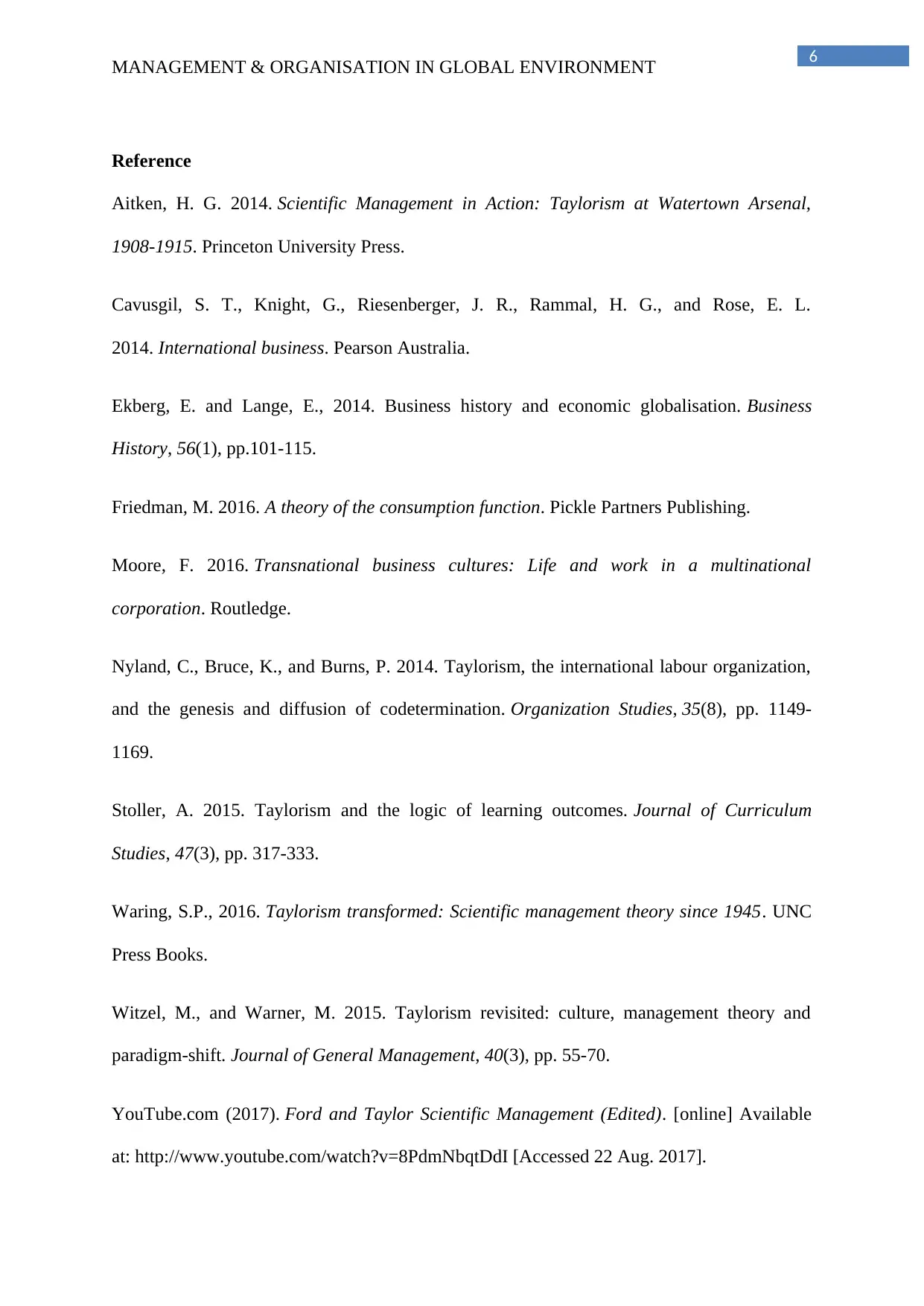
6
MANAGEMENT & ORGANISATION IN GLOBAL ENVIRONMENT
Reference
Aitken, H. G. 2014. Scientific Management in Action: Taylorism at Watertown Arsenal,
1908-1915. Princeton University Press.
Cavusgil, S. T., Knight, G., Riesenberger, J. R., Rammal, H. G., and Rose, E. L.
2014. International business. Pearson Australia.
Ekberg, E. and Lange, E., 2014. Business history and economic globalisation. Business
History, 56(1), pp.101-115.
Friedman, M. 2016. A theory of the consumption function. Pickle Partners Publishing.
Moore, F. 2016. Transnational business cultures: Life and work in a multinational
corporation. Routledge.
Nyland, C., Bruce, K., and Burns, P. 2014. Taylorism, the international labour organization,
and the genesis and diffusion of codetermination. Organization Studies, 35(8), pp. 1149-
1169.
Stoller, A. 2015. Taylorism and the logic of learning outcomes. Journal of Curriculum
Studies, 47(3), pp. 317-333.
Waring, S.P., 2016. Taylorism transformed: Scientific management theory since 1945. UNC
Press Books.
Witzel, M., and Warner, M. 2015. Taylorism revisited: culture, management theory and
paradigm-shift. Journal of General Management, 40(3), pp. 55-70.
YouTube.com (2017). Ford and Taylor Scientific Management (Edited). [online] Available
at: http://www.youtube.com/watch?v=8PdmNbqtDdI [Accessed 22 Aug. 2017].
MANAGEMENT & ORGANISATION IN GLOBAL ENVIRONMENT
Reference
Aitken, H. G. 2014. Scientific Management in Action: Taylorism at Watertown Arsenal,
1908-1915. Princeton University Press.
Cavusgil, S. T., Knight, G., Riesenberger, J. R., Rammal, H. G., and Rose, E. L.
2014. International business. Pearson Australia.
Ekberg, E. and Lange, E., 2014. Business history and economic globalisation. Business
History, 56(1), pp.101-115.
Friedman, M. 2016. A theory of the consumption function. Pickle Partners Publishing.
Moore, F. 2016. Transnational business cultures: Life and work in a multinational
corporation. Routledge.
Nyland, C., Bruce, K., and Burns, P. 2014. Taylorism, the international labour organization,
and the genesis and diffusion of codetermination. Organization Studies, 35(8), pp. 1149-
1169.
Stoller, A. 2015. Taylorism and the logic of learning outcomes. Journal of Curriculum
Studies, 47(3), pp. 317-333.
Waring, S.P., 2016. Taylorism transformed: Scientific management theory since 1945. UNC
Press Books.
Witzel, M., and Warner, M. 2015. Taylorism revisited: culture, management theory and
paradigm-shift. Journal of General Management, 40(3), pp. 55-70.
YouTube.com (2017). Ford and Taylor Scientific Management (Edited). [online] Available
at: http://www.youtube.com/watch?v=8PdmNbqtDdI [Accessed 22 Aug. 2017].
Paraphrase This Document
Need a fresh take? Get an instant paraphrase of this document with our AI Paraphraser
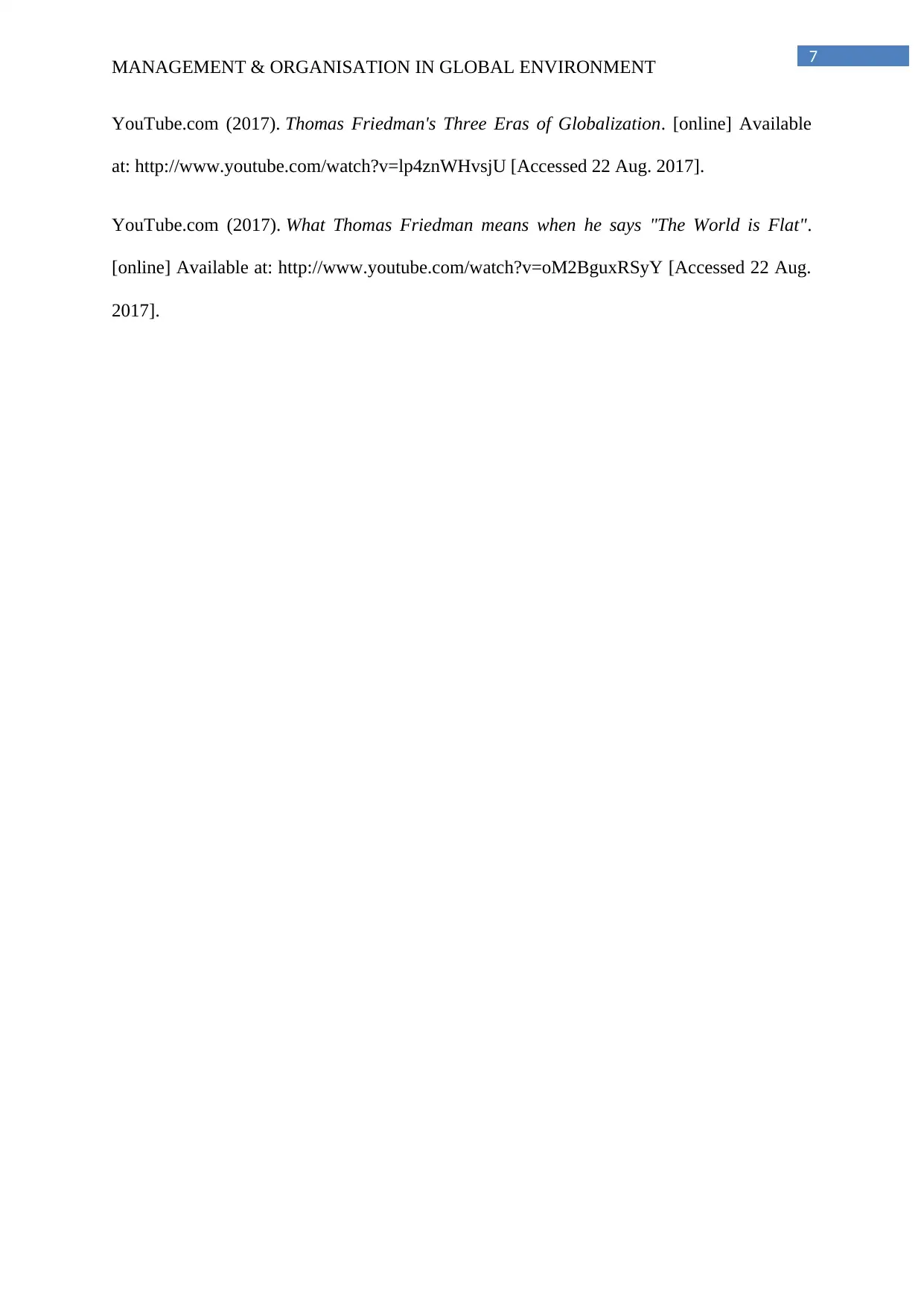
7
MANAGEMENT & ORGANISATION IN GLOBAL ENVIRONMENT
YouTube.com (2017). Thomas Friedman's Three Eras of Globalization. [online] Available
at: http://www.youtube.com/watch?v=lp4znWHvsjU [Accessed 22 Aug. 2017].
YouTube.com (2017). What Thomas Friedman means when he says "The World is Flat".
[online] Available at: http://www.youtube.com/watch?v=oM2BguxRSyY [Accessed 22 Aug.
2017].
MANAGEMENT & ORGANISATION IN GLOBAL ENVIRONMENT
YouTube.com (2017). Thomas Friedman's Three Eras of Globalization. [online] Available
at: http://www.youtube.com/watch?v=lp4znWHvsjU [Accessed 22 Aug. 2017].
YouTube.com (2017). What Thomas Friedman means when he says "The World is Flat".
[online] Available at: http://www.youtube.com/watch?v=oM2BguxRSyY [Accessed 22 Aug.
2017].
1 out of 8
Related Documents
Your All-in-One AI-Powered Toolkit for Academic Success.
+13062052269
info@desklib.com
Available 24*7 on WhatsApp / Email
![[object Object]](/_next/static/media/star-bottom.7253800d.svg)
Unlock your academic potential
Copyright © 2020–2025 A2Z Services. All Rights Reserved. Developed and managed by ZUCOL.

